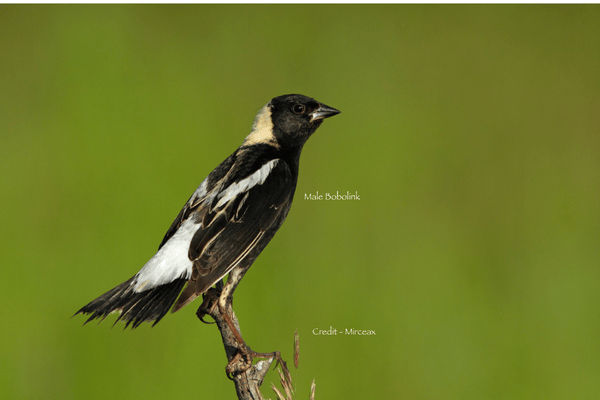The Couch Preserve holds a special place in my heart. Adjacent to Huntington Park, the Preserve is a summer breeding habitat for bobolinks. A species of migrating grassland birds, the bobolink (Dolichonyx oryzivorus) is a small blackbird and the only member of the genus Dolichonyx. Oryzivorus means “rice-eating” and refers to this bird’s appetite for rice and other grains, especially during migration and winter.
The bobolink breeds in the summer in the United States and Canada, mostly in the northern U.S.
The Couch Preserve is ideal for bobolinks, who require large grasslands of at least 10 acres in size. To be successful, bobolinks must have fields that are not only big but also left unmowed well into the summer.
Bobolinks arrive in early May. It is common to see males chasing each other to establish nesting territory and fighting over the attention of the females. Perched on stems of grasses and other perennial plants, the breeding male bobolinks are striking in appearance with their “backward tuxedo” coloring consisting of black faces, chests, and bellies contrasting with a white back and a rich straw-colored cap at the rear of the head. Added to this is an intricate, bubbly song. Females are light brown, with black stripes that help them disappear into the grass. Interestingly, as the summer ends, the male bobolink molts into a buff and brown female-like plumage.

Bobolinks are polygynous and polyandrous—that is, both males and females can have multiple mates within a breeding season. They build their nests on the ground, hidden in tall, dense vegetation, using materials like coarse dead grasses, weed stems, and other plants. This nesting strategy protects them from their natural predators but also makes them extremely vulnerable to destruction by mowing operations during this critical period. That is why the mowing of the Couch Preserve is delayed until the Fall.
The female is responsible for nest construction, weaving, and building a cup-shaped depression lined with softer grass. With clutches of three to seven eggs, bobolink eggs are typically pale bluish-gray to reddish brown, with irregular spots of brown and lavender. After an incubation period of 11-14 days, the nestlings leave the nest at 10-11 days after hatching in June or July and can generally fly by late July. The eggs laid by a single female may have multiple fathers.
By early September, bobolinks gather in flocks of up to 100 birds in preparation for travel to wintering grounds in South America – a trip of over 6,000 miles, among the longest migrations of any North American songbird. During this epic journey, Bobolinks navigate by sensing the earth’s magnetic field, using iron oxide in bristles in their nasal cavities.They also orient themselves by stars in the night sky. In spring, they head north, returning yearly to the same field or those nearby to raise their young.
Sadly, the bobolinks are in decline due to habitat loss and untimely mowing. They are listed as a Species of Concern in Connecticut. The good news is that Connecticut is home to a dozen or more population throughout the state, mainly in nature preserves such as the Couch Preserve.

.png)


.png)
060324.png)

.png)


